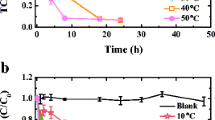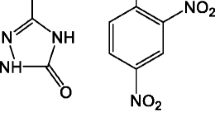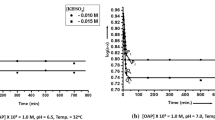Abstract
Mechanism of the \(\{\text{M}{{\text{o}}_{\text{132}}}\}~=~{{(\text{N}{{\text{H}}_{\text{4}}})}_{\text{42}}}[\text{Mo}_{72}^{\text{VI}}\text{Mo}_{60}^{\text{V}}{{\text{O}}_{\text{372}}}{{(\text{C}{{\text{H}}_{\text{3}}}\text{COO})}_{\text{3}0}}{{({{\text{H}}_{\text{2}}}\text{O})}_{\text{72}}}]\)(~300H2O)·(~10CH3 COONH4) polyoxomolybdate degradation in an aqueous solution is proposed and substantiated for the time using kinetic modeling. The mechanism includes four stages: I) non-catalytic cleavage of the Mo–O bond between the polyoxomolybdate fragments; II) recovery of the bonds between the polyoxomolybdate fragments; III) catalytic cleavage of the Mo–O bond between the polyoxomolybdate fragments; IV) increase of O2 concentration due to the decay of the conjugate pair \(\text{O}_{2}^{\bullet -}/\text{HO}{{\text{O}}^{\bullet }}\) releasing the oxygen molecule and due to O2 diffusion from the gas phase into the polyoxomolybdate aqueous solution. A kinetic model of the considered process is proposed. It is shown that bond recovery prevails over bond cleavage in the polyoxomolybdate due to low residual O2 concentration in the solution. At the same time, increasing the O2 concentration in the solution up to some “critical” value restarts the avalanche-like autocatalytic process of Mo–O bond cleavage in the polyoxomolybdate.










Similar content being viewed by others
Notes
* Hereinafter, POM structures inside the curly brackets {} are shown in a simplified form showing only the metal atoms in the POM composition.
** This polyoxomolybdate is referred to below as {Mo132} and is assumed to appear in an aqueous solution; the aqueous solution of {Mo132} is referred to below simply as "solution".
* Strictly speaking, each {Mo2} is connected to the cluster by two chemical bonds; therefore, these are not chemical bonds, but bonds in {Mo132} represented by a graph.
* The mechanism is described in terms of “stages” rather than in terms of “reactions”, because, firstly, each stage consists of several successive reactions, and secondly, the stage (IV) is partially non-chemical in nature.
REFERENCES
A. Ostroushko, I. Gagarin, K. Grzhegorzhevskii, I. Gette, D. Vlasov, A. Ermoshin, and I. Danilova. J. Mol. Liq., 2019, 110910. https://doi.org/10.1016/j.molliq.2019.110910
A. Rezaeifard, R. Mokhtari, Z. Garazhian, M. Jafarpour, and K. Grzhegorzhevskii. Inorg. Chem., 2022, 61(20), 7878-7889. https://doi.org/10.1021/acs.inorgchem.2c00476
S. Mouanni, D. Amitouche, T. Mazari, and C. Rabia. Appl. Petrochem. Res., 2019, 9(2), 67-75. https://doi.org/10.1007/s13203-019-0226-0
Y. Zhou, G. Chen, Z. Long, and J. Wang. RSC Adv., 2014, 4(79), 42092-42113. https://doi.org/10.1039/C4RA05175K
S. Ishikawa, Z. Zhang, and W. Ueda. ACS Catal., 2018, 8(4), 2935-2943, https://doi.org/10.1021/acscatal.7b02244
K. Shimoda, S. Ishikawa, M. Tashiro, M. Kumaki, N. Hiyoshi, and W. Ueda. Inorg. Chem., 2020, 59(8), https://doi.org/10.1021/acs.inorgchem.9b03713
A. Rezaeifard, M. Jafarpour, R. Haddad, H. Tavallaei, and M. Hakimi. J. Clust. Sci., 2015, 26(5), 1439-1450. https://doi.org/10.1007/s10876-015-0876-8
A. Rezaeifard, R. Haddad, M. Jafarpour, and M. Hakimi. J. Am. Chem. Soc., 2013, 135(27), 10036-10039. https://doi.org/10.1021/ja405852s
F. Jalilian, B. Yadollahi, M. Farsani, S. Tangestaninejad, H. Rudbari, and R. Habibi. RSC Adv., 2015, 5(86), 70424-70428. https://doi.org/10.1039/C5RA12488C
R. Mokhtari, A. Rezaeifard, M. Jafarpour, and A. Farrokh. Catal. Sci. Technol., 2018, 8(18), 4645-4656. https://doi.org/10.1039/C8CY00603B
Z. Garazhian, A. Rezaeifard, and M. Jafarpour. RSC Adv., 2019, 9(60), 34854-34861. https://doi.org/10.1039/C9RA06581D
A. Davoodnia and A. Nakhaei. Synth. React. Inorg., Met.-Org., Nano-Met. Chem., 2016, 46(7), 1073-1080. https://doi.org/10.1080/15533174.2015.1004419
A. Panagiotopoulos, A. Douvas, P. Argitis, and A. Coutsolelos. ChemSusChem, 2016, 9(22), 3213-3219. https://doi.org/10.1002/cssc.201600995
F. Jalilian, B. Yadollahi, M. Farsani, S. Tangestaninejad, H. Rudbari, and R. Habibi. Catal. Commun., 2015, 66, 107-110. https://doi.org/10.1016/j.catcom.2015.03.032
Z. Garazhian, A. Rezaeifard, M. Jafarpour, and A. Farrokhi. ACS Appl. Nano Mater., 2020, 3(1), 648-657. https://doi.org/10.1021/acsanm.9b02174
Y. Zhou, L. Qin, C. Yu, T. Xiong, L. Zhang, W. Ahmad, and H. Han. RSC Adv., 2014, 4(97), 54928-54935. https://doi.org/10.1039/C4RA07700H
D. Fan and J. Hao. J. Colloid Interface Sci., 2009, 333(2), 757-763. https://doi.org/10.1016/j.jcis.2009.01.034
A. Müller, S. Sarkar, S. Shah, H. Bögge, M. Schmidtmann, S. Sarkar, and V. Schünemann. Angew. Chem., Int. Ed. Engl., 1999, 38(21), 3238-3241. https://doi.org/10.1002/(sici)1521-3773(19991102)38:21<3238::aid-anie3238>3.0.co;2-6
A. Müller, E. Krickemeyer, J. Meyer, H. Bögge, F. Peters, W. Plass, and C. Menke. Angew. Chem., Int. Ed. Engl., 1995, 34(19), 2122-2124. https://doi.org/10.1002/anie.199521221
A. Müller, E. Beckmann, H. Bögge, M. Schmidtmann, and A. Dress. Inorg. Chem., 2002, 41(7), 1162-1167. https://doi.org/10.1002/1521-3773(20020402)41:7<1162::aid-anie1162>3.0.co;2-8
K. Grzhegorzhevskii, N. Shevtsev, A. Abushaeva, D. Chezganov, and A. Ostroushko. Russ. Chem. Bull., 2020, 69(4), 804–814. https://doi.org/10.1007/s11172-020-2836-1
B. Kowalewski, J. Poppe, U. Demmer, E. Warkentin, T. Dierks, U. Ermler, and K. Schneider. J. Am. Chem. Soc., 2012, 134(23), 9768-9774. https://doi.org/10.1021/ja303084n
G. Marin, G. Yablonsky, and D. Constales. Kinetics of Chemical Reactions - Decoding Complexity, 2nd ed. Wiley-VCH, 2019. https://doi.org/10.1002/9783527808397
H. Kielhöfer. Bifurcation Theory: An Introduction with Applications to Partial Differential Equations: Applied Mathematical Sciences, Vol. 156. Springer, 2012. https://doi.org/10.1007/978-1-4614-0502-3
A. Müller, E. Krickemeyer, H. Bögge, M. Schmidtmann, and F. Peters. Angew. Chem., Int. Ed. Engl., 1998, 37, 3359-3363. https://doi.org/10.1002/(SICI)1521-3773(19981231)37:24<3359::AID-ANIE3359>3.0.CO;2-J
K. Grzhegorzhevskii, P. Zelenovskiy, O. Koryakova, and A. Ostroushko. Inorg. Chim. Acta, 2019, 489, 287-300. https://doi.org/10.1016/j.ica.2019.01.016
T. Yamase. Chem. Rev., 1998, 98(1), 307-326. https://doi.org/10.1021/cr9604043
C. Schäffer, A. Todea, P. Gouzerh, and A. Müller. Chem. Commun., 2012, 48, 350-352. https://doi.org/10.1039/c1cc15907k
A. Müller, S. Polarz, S. Das, E. Krickemeyer, H. Bögge, M. Schmidtmann, and B. Hauptfleisch. Angew. Chem., Int. Ed., 1999, 38(21), 3241-3245. https://doi.org/10.1002/(sici)1521-3773(19991102)38:21<3241::aid-anie3241>3.0.co;2-9
D. Melgar, N. Bandeira, J. Avalos, and C. Bo. Phys. Chem. Chem. Phys., 2017, 19(7), 5343-5350. https://doi.org/10.1039/c6cp08511c
V. Korenev, P. Dorovatovskii, V. Lazarenko, P. Abramov, and M. Sokolov. CrystEngComm, 2022, 24, 321-329. https://doi.org/ 10.1039/d1ce01121a
K. Tereshchenko, D. Shiyan, N. Ulitin, S. Kolesov, R. Deberdeev, and Kh. Kharlampidi. Chem. Eng. J., 2021, 433(6), 133537. https://doi.org/10.1016/j.cej.2021.133537
A. Scheeline, D. Olson, E. Williksen, G. Horras, M. Klein, and R. Larter. Chem. Rev., 1997, 97(3), 739-756. https://doi.org/ 10.1021/CR960081A
J. W. Peters and C. S. Foote. J. Am. Chem. Soc., 1976, 98(3), 873-875. https://doi.org/10.1021/ja00419a058
M. Hayyan, M. Hashim, and I. AlNashef. Chem. Rev., 2016, 116(5), 3029-3085. https://doi.org/10.1021/acs.chemrev.5b00407
L. Klimina, B. Lokshin, and V. Samsonov. J. Appl. Math. Mech., 2017, 81(6), 442-449. https://doi.org/10.1016/j.jappmathmech.2018.03.012
Funding
This work was funded by the Tatarstan Academy of Sciences (contract No. 05-47- yuG of 28.04.2022).
Author information
Authors and Affiliations
Corresponding author
Ethics declarations
The authors declare that they have no conflicts of interests.
Additional information
Russian Text © The Author(s), 2022, published in Zhurnal Strukturnoi Khimii, 2022, Vol. 63, No. 12, 103434.https://doi.org/10.26902/JSC_id103434
Rights and permissions
About this article
Cite this article
Tereshchenko, K.A., Shiyan, D.A., Grzhegorzhevskii, K.V. et al. KINETICS AND MECHANISM OF A SELF- OSCILATION REACTION OF KEPLERATE-TYPE POLYOXOMOLIBDATE DEGRADATION IN AN AQUEOUS SOLUTION. J Struct Chem 63, 2004–2019 (2022). https://doi.org/10.1134/S0022476622120125
Received:
Revised:
Accepted:
Published:
Issue Date:
DOI: https://doi.org/10.1134/S0022476622120125




